Did you know that 60-70% of birds eat seeds, worms, larvae, and insects? This makes new grass a big target for them. It’s a big problem for your lawn.
Keeping birds away from your grass seed is key to a healthy lawn. We’ll show you how to spot bird problems and use effective ways to keep them off. This guide will help you protect your lawn and make it grow strong.
Key Takeaways
- 60-70% of birds feed on seeds, worms, larvae, and insects, making freshly seeded grass a prime target
- Identifying bird damage on your lawn includes finding small holes in the soil, approximately 1-1.5 inches in diameter
- Various physical barriers, such as netting and coverings, can effectively protect grass seed from bird interference
- Natural and commercial bird repellents, including motion-activated sprinklers, can deter birds without harming them
- Proper timing and strategic seeding techniques can also minimize the impact of birds on your new lawn
Understanding Bird Behavior and Lawn Damage
Birds love freshly seeded lawns because they’re full of easy-to-get grass seeds. Birds like sparrows, finches, pigeons, blackbirds, meadowlarks, and cardinals find these seeds tasty. They not only eat the seeds but also dig up the seedlings while looking for worms or insects.
Why Birds Are Attracted to Freshly Seeded Lawns
Newly seeded lawns are a feast for birds. The exposed seeds and young grass shoots are a tasty and nutritious meal. Knowing how birds behave and eat helps us find ways to prevent birds from eating grass seed and use bird repellents for grass seed.
Common Types of Birds That Target Grass Seeds
- Sparrows
- Finches
- Pigeons
- Blackbirds
- Meadowlarks
- Cardinals
Identifying Bird Damage on Your Lawn
Spotting bird damage on your lawn is key to fixing the problem. Look for small holes or uneven grass growth. These signs show birds are eating your seeds or messing with the seedlings. Watching for these signs helps you pick the best bird repellents for grass seed and strategies to prevent birds from eating grass seed.
Physical Barriers for Seed Protection
Physical barriers are great for keeping birds off your lawn after seeding. Burlap sheets are a top choice. They let water, sunlight, and air in but keep birds out. Burlap also keeps the soil moist and stops weeds, helping your grass grow well.
To use burlap right, pin it down with wire or staples. This makes sure it fits snugly over your seeds. But, take it off when the seeds start growing. This lets the young grass get the sunlight it needs to grow strong.
- Burlap sheets provide a physical barrier to keep birds from accessing grass seeds
- Burlap allows water, sunlight, and air to pass through, promoting healthy seed germination
- Burlap helps retain soil moisture and prevent weed growth
- Secure burlap with pin wires or landscape staples for a tight fit
- Remove burlap once seeds have germinated to avoid blocking sunlight
Using these barriers can help you keep birds away from grass seed. This way, your lawn will stay lush and healthy. Adding these barriers to other bird-deterrent methods gives your grass the best protection.
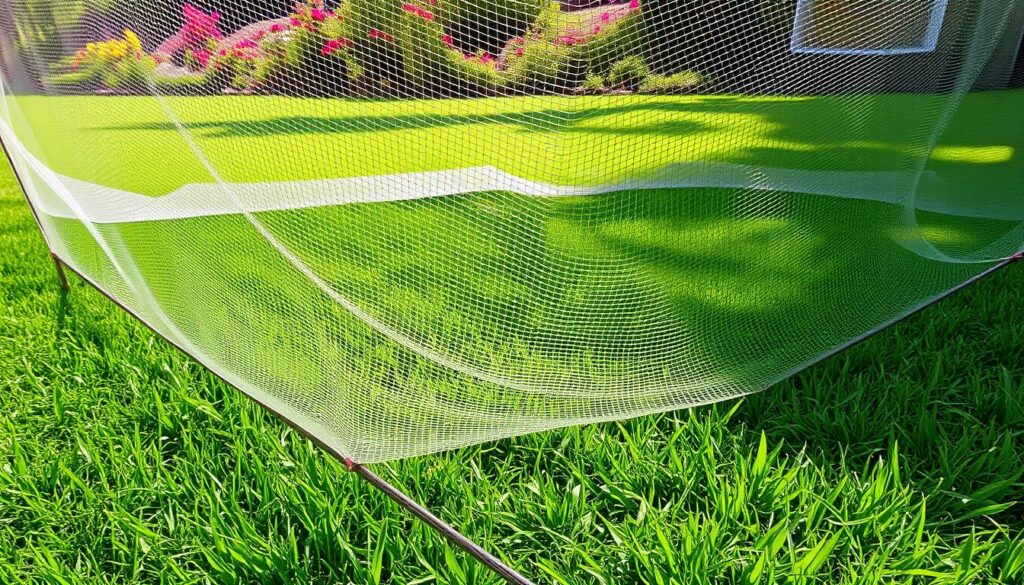
Using Bird Netting as a Protective Measure
Keeping birds away from your new lawn is key for it to grow well. Bird netting is a great way to do this. It’s light and flexible, letting sunlight, water, and air reach the seeds.
Proper Installation Techniques
To set up bird netting right, follow some important steps. The netting should be placed a few inches above the soil surface. This keeps birds from getting to the seeds. Use stakes, weights, or pins to keep the netting tight to the ground.
Best Types of Netting for Lawn Protection
- Go for netting made of polyurethane or polyethylene. These are tough, weather-proof, and easy to put up.
- The mesh size should stop many birds, like quails and sparrows, from getting to the grass seed protection.
- Make sure the netting can handle sunlight. UV-resistant netting stays strong and works well over time.
Using bird netting for grass seed and installing it correctly helps protect your lawn. It lets your grass grow strong and healthy.
How to Keep Birds Off Grass Seed: Essential Methods
Keeping birds away from your lawn can be tough. But, with the right strategies, you can protect your grass seed. We’ll look at visual, sound-based, and feeding station methods to keep birds off your lawn.
Visual deterrents are very effective. Mirrors and holographic tapes can dazzle birds, making them stay away. Brightly colored flags and windmills also work by disturbing their vision and making noise.
- Utilize reflective objects like mirrors and holographic tapes to create a dazzling effect
- Deploy brightly colored flags and windmills to disturb birds’ vision and generate noise
Sound-based deterrents are also great. Bird distress calls or high-frequency noises can scare them off. Devices like the Bird Chase Super Sonic can be placed around your lawn to cover more area.
| Product | Features | Coverage Area |
|---|---|---|
| Bird Chase Super Sonic | Over 22 pre-recorded bird distress calls, 110-120v outlet | Up to 1 acre |
| Solar Bird Chase Super Sonic | Solar-powered, automatic power-off feature | Up to 1 acre |
Creating alternative feeding stations can also help. Place bird feeders with millet or sunflower seeds to draw birds away from your lawn.
Using a mix of deterrent methods is usually the best approach. Keep an eye on your lawn and adjust your strategies as needed. This will help your new grass grow well.
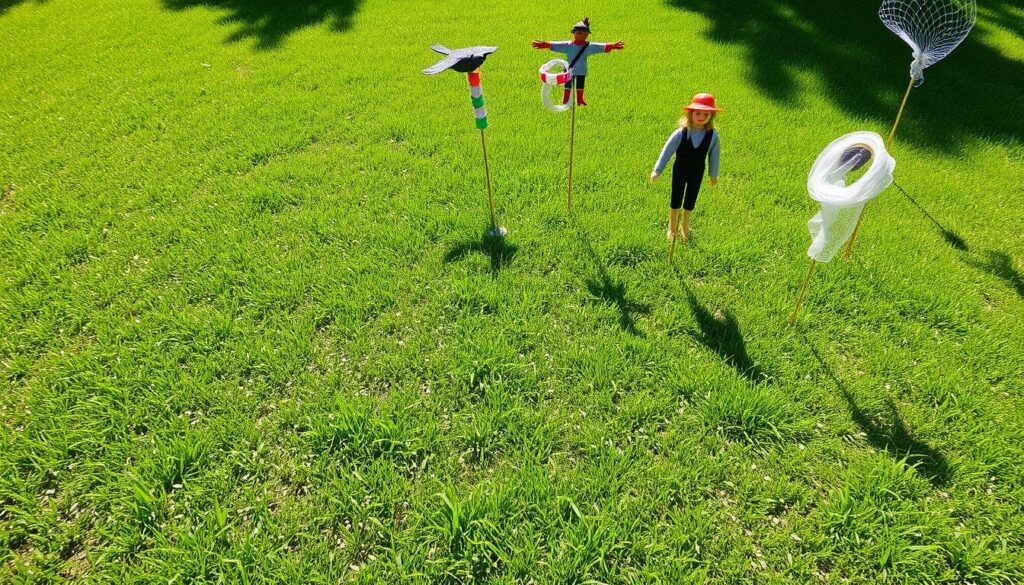
Natural Bird Deterrents and Repellents
Keeping birds away from your lawn doesn’t need harsh chemicals or complicated setups. Discover natural bird deterrents and repellents. They protect your grass seed without harming the environment.
Homemade Solutions
Try simple DIY methods to keep birds away. A weak black tea or peppermint oil spray works well. The bitter taste and strong scent keep birds from eating your grass seed.
Dilute these solutions right and spread them over your seeded area. Reapply after rain or when you water your lawn.
Commercial Repellent Options
For a lasting solution, look at commercial bird repellents. These products often have Aluminum Ammonium Sulphate. It’s safe for plants and animals but tastes bitter to birds.
When using natural bird deterrents for grass seed, follow the instructions. This ensures you use the right amount and cover the area well.
Using both homemade and commercial bird repellents for grass seed creates a strong defense. It keeps your lawn safe without harming the environment. Try different methods to find what works best for you.
Visual Deterrents and Reflective Objects
Visual deterrents and reflective objects are great for keeping birds away from your lawn. They use birds’ excellent vision to scare them off. This makes birds feel afraid and they leave quickly.
Using CDs, aluminum foil strips, or bird tape can be very effective. These items reflect light and move with the wind. They confuse and scare birds, keeping them away from your keep birds away from grass seed area.
Setting up fake predators like rubber snakes or owl decoys also works well. These objects make birds think there’s a real predator around. This makes them not want to come near your bird deterrents for new lawns.
- Bright-colored flags and windmills can also scare birds away. Their bright colors and movement catch birds’ attention, making them look for safer places.
- It’s key to move these visual deterrents around often. This keeps birds from getting used to them.
Visual cues and reflective surfaces can make your lawn unappealing to birds. This method is safe for birds and the environment. It’s a simple yet effective way to keep birds from eating your grass seed.
Strategic Use of Motion-Activated Sprinklers
Motion-activated sprinklers are a smart way to keep birds off your lawn. They detect bird movement and spray water to scare them away. This method is both effective and good for the environment.
Coverage Areas and Installation Tips
For motion-activated sprinklers to work well, they need to be placed right. They can spot birds up to 30 to 60 feet away. Make sure to set them up so they cover all the seeded areas.
It’s important to install them so they only go off for birds, not for small animals or leaves. This saves water and keeps the sprinklers working right.
Best Time to Activate Systems
The best time to turn on your sprinklers is when birds are most active. This is usually in the morning and late afternoon. This timing helps scare birds away when they’re looking for food.
Adjust the sprinklers’ sensitivity to avoid false starts. This way, you keep birds away without wasting water.
Motion-activated sprinklers are a great way to protect your lawn from birds. By planning where and when to use them, you can keep your lawn healthy and green.
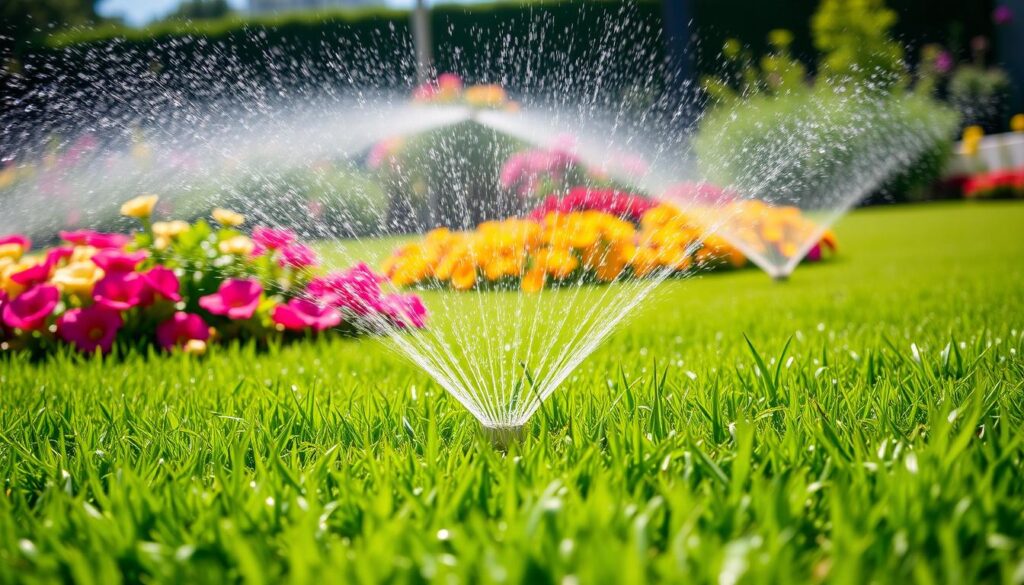
“Motion-activated sprinklers are a game-changer when it comes to deterring birds from eating grass seed. The burst of water startles them, effectively keeping them away without harming them.”
Mulch and Ground Cover Solutions
Keeping birds away from your grass seed can be tough. But, using the right mulch and ground cover can help a lot. A certified weed-free straw mulch is a great choice. It stops weeds and hides the seeds from birds.
Make sure to spread the mulch thinly. This lets enough light reach the soil. It keeps the soil moist, controls temperature, and hides the seeds from birds. As the seeds grow, you can slowly remove the mulch to let them get sunlight.
There are other ways to keep birds out too. You can use garden fleece or lightweight polythene sheeting. These make it hard for birds to get to the seeds.
The secret to protecting your grass seed is finding the right mix. You need to help the seeds grow while keeping birds away. Mulch and ground cover can make your lawn strong and bird-free.
Alternative Feeding Stations and Diversion Tactics
To stop birds from eating grass seed and keep birds away from grass seed, try alternative feeding stations. These can draw birds away from your lawn. This way, your freshly seeded grass is less likely to be eaten.
Optimal Feeder Placement
Place bird feeders strategically. Put them far from your seeded lawn but still easy for birds to reach. Make sure they’re not near trees or poles that squirrels could climb.
Types of Bird Feed to Use
- Black oil sunflower seeds
- Peanuts
- Dried fruit
- Millet
- Cracked corn
- Suet cakes
These bird feeds attract many bird species. They’re great for keeping birds away from your grass seed. Always clean your feeders to keep birds healthy and the food fresh.
For big areas or lots of birds, use more than one feeder. This gives birds plenty of food and keeps them from eating your grass seed.
“Providing an alternative feeding station for squirrels filled with nuts, seeds, and fruits can distract them from raiding the bird feeder.”
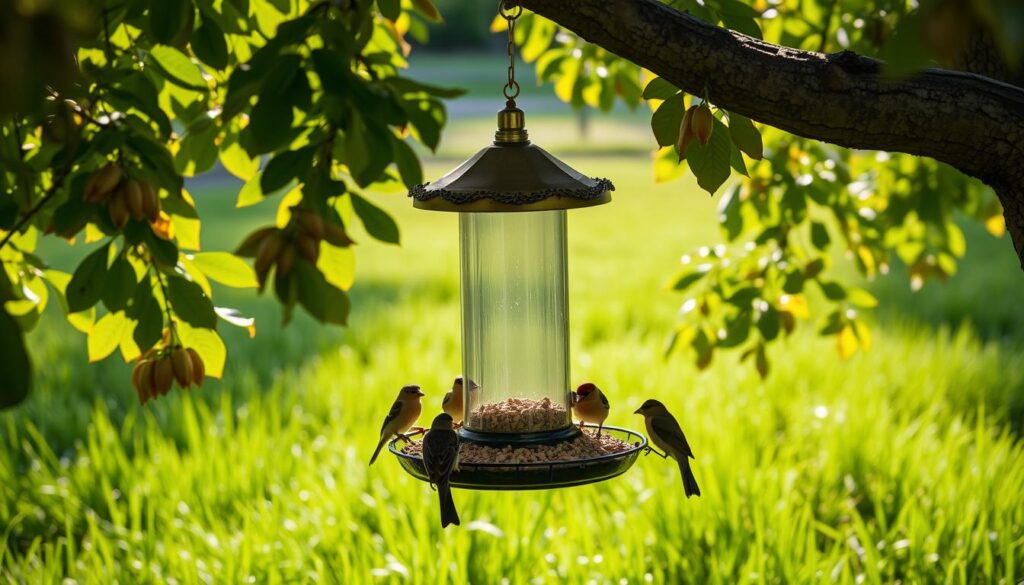
With these feeding stations and tactics, you can make your yard more appealing to birds. This reduces the chance of them eating your grass seed. It helps prevent birds from eating grass seed and keep birds away from grass seed.
Timing Your Grass Seeding for Success
Getting the timing right for grass seeding is key to avoiding bird damage. Late summer and early fall are best for seed germination because of the soil’s warmth. But, you must also think about when birds migrate and breed.
Choose fast-germinating grass or special absorption seeds to keep birds away. These seeds grow quickly, making them less appealing to birds. Also, watering well helps seeds settle, making them less visible to birds.
Studies show that seed starter mats or erosion control blankets can boost grass seed germination. They protect seeds from birds and keep the soil moist. Bird-repellent coated grass seed products also improve moisture retention and germination rates, helping your lawn grow well.
By timing your seeding right and using protective methods, you can grow a beautiful lawn. And, you’ll keep birds from ruining it.
Sound-Based Bird Deterrent Systems
Keeping your lawn bird-free is easier with sound-based systems. These systems use audio cues to scare birds away. They make your lawn an unwelcome place for birds, protecting your grass seed.
Using pre-recorded predator calls or bird distress signals is a good strategy. These sounds scare birds, making them leave your lawn. They’re great for keeping away pigeons, crows, and sparrows.
Ultrasonic bird deterrents are another effective option. They make sounds birds can hear but humans can’t. This creates a bad environment for birds, keeping them away without bothering anyone else.
- Utilize pre-recorded predator calls or bird distress signals to create an unwelcoming environment for birds.
- Incorporate ultrasonic bird deterrents that emit high-frequency sounds detectable by birds but inaudible to humans.
- Vary the timing and location of your sound-based deterrents to prevent birds from becoming accustomed to the system.
- Combine sound-based deterrents with visual cues, such as reflective objects or scarecrows, for enhanced effectiveness.
Sound-based bird deterrents can keep your lawn bird-free. This lets you enjoy a lush, vibrant landscape without unwanted visitors.
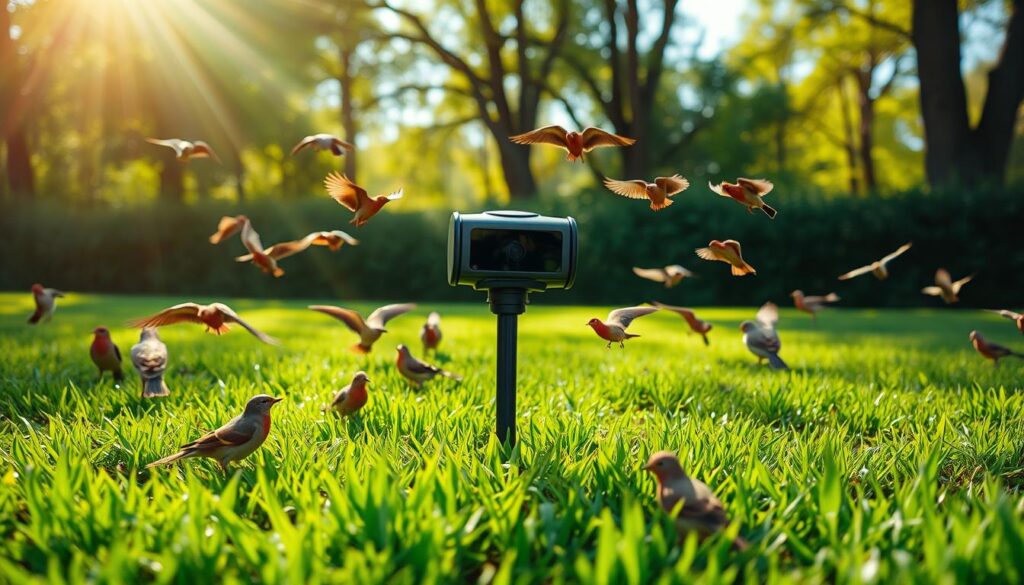
Chemical-Free Protection Methods
Looking for ways to keep birds away from your grass seed without chemicals? There are many natural options. Organic repellents, smart planting, and changing your yard can help. These methods keep your lawn safe without harsh chemicals.
Organic Alternatives
Essential oil sprays or repellents with garlic, capsaicin, or castor oil are good choices. They work by using a bird’s sense of smell or taste. This keeps birds from eating your grass seed.
Environmental Considerations
Make other parts of your yard bird-friendly to keep them off your lawn. Plant native grasses and bird-resistant plants. Adding marigolds or lavender can also help. A healthy, balanced yard is key to managing birds naturally.
FAQ
Why are birds attracted to freshly seeded lawns?
Birds see new lawns as an easy meal. Grass seeds are a quick snack for birds like sparrows, finches, pigeons, blackbirds, meadowlarks, and cardinals.
What are the common types of birds that target grass seeds?
Birds like sparrows, finches, pigeons, blackbirds, meadowlarks, and cardinals often go after grass seeds.
How can I identify if birds are damaging my grass seed?
Look for small holes in the soil, about 1-1.5 inches wide. Also, check if the grass is growing unevenly.
What are the most effective physical barriers to protect grass seeds from birds?
Burlap sheets and bird netting work well. Burlap lets water and sunlight through but keeps seeds safe. Bird netting, with the right mesh, keeps birds out.
How do I properly install and use bird netting?
Put bird netting a few inches above the soil. This stops birds from getting through. Make sure it covers everything and secure the edges to keep birds out.
What are some essential methods for keeping birds off grass seed?
Use visual and sound deterrents, and set up alternative feeding stations. Mixing these methods works best.
What are some natural and chemical-free bird deterrents for grass seed?
Try homemade sprays like weak black tea or peppermint oil. Plant bird-resistant grass and create diverse habitats to draw birds away.
How can visual deterrents help keep birds away from grass seed?
Reflective objects like CDs or aluminum foil strips scare birds with moving reflections. Fake predators like rubber snakes or owl decoys also work.
How do motion-activated sprinklers work to keep birds away from grass seed?
These sprinklers spray water when they see birds. It’s a harmless way to keep them away. Place them where birds are most active.
How can mulch and ground covers help protect grass seeds from birds?
Mulch and ground covers hide seeds from birds. They also help with weeds, keep moisture in, and regulate soil temperature.
How can setting up bird feeders away from the lawn help protect grass seed?
Bird feeders in other parts of the yard distract birds from the seeded lawn. This gives them a different food source and reduces seed damage.
When is the best time to seed a lawn to minimize bird damage?
Seed in late summer or early fall when soil is warm. Avoiding peak bird seasons helps too.
How can sound-based deterrents help keep birds away from grass seed?
Sounds like predator calls or distress signals scare birds. Ultrasonic devices that birds can’t hear also work well.
What are some chemical-free and organic methods for protecting grass seed from birds?
Use organic repellents and plant bird-resistant grass. Create diverse habitats and use companion planting with herbs or flowers that repel birds.
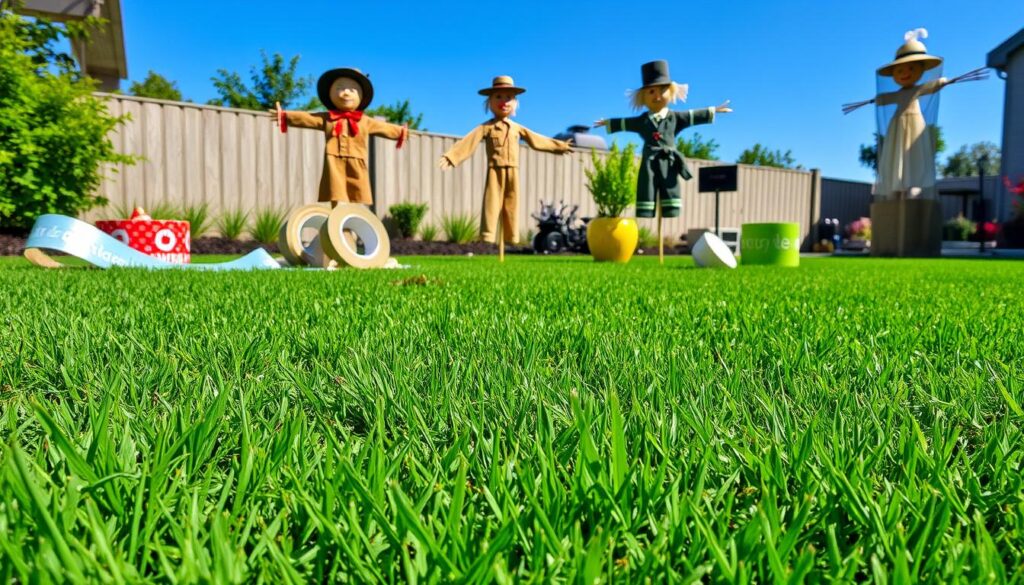
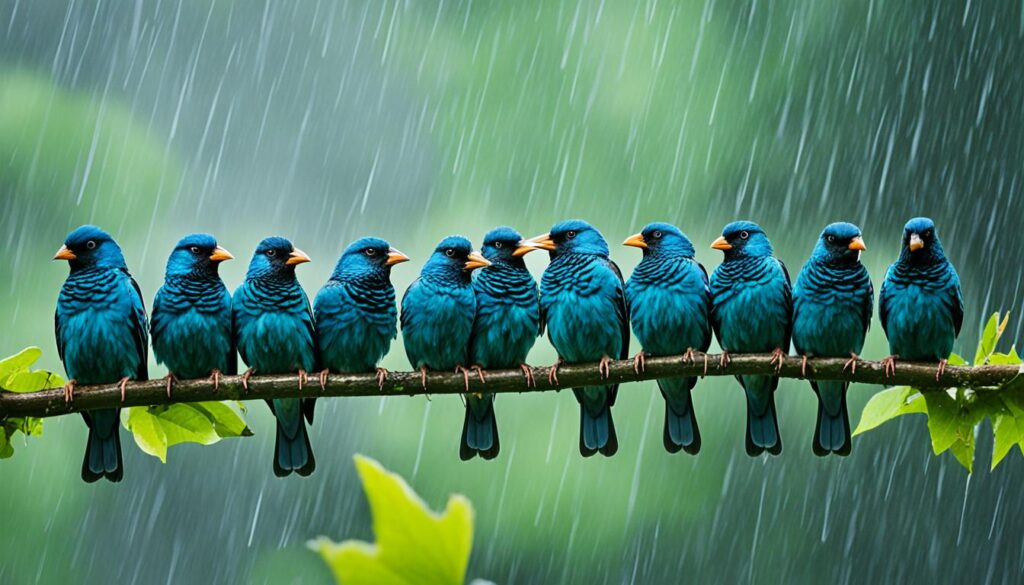
It’s hard to find knowledgeable people on this topic, but you sound like you know what you’re talking about! Thanks
Thanks for sharing. I read many of your blog posts, cool, your blog is very good.
Your article helped me a lot, is there any more related content? Thanks!
Can you be more specific about the content of your article? After reading it, I still have some doubts. Hope you can help me.
Thanks for sharing. I read many of your blog posts, cool, your blog is very good. https://www.binance.info/en/register?ref=JHQQKNKN
Can you be more specific about the content of your article? After reading it, I still have some doubts. Hope you can help me.
Rattling nice design and style and great subject matter, very little else we require : D.
Can you be more specific about the content of your article? After reading it, I still have some doubts. Hope you can help me.
Thanks for sharing. I read many of your blog posts, cool, your blog is very good.
Can you be more specific about the content of your article? After reading it, I still have some doubts. Hope you can help me.
I don’t usually comment but I gotta admit appreciate it for the post on this one : D.
Can you be more specific about the content of your article? After reading it, I still have some doubts. Hope you can help me.
Birds can definitely be a challenge when it comes to maintaining a healthy lawn. Since they love seeds, worms, and insects, they can quickly devour the grass seeds you’ve just planted, ruining your chances of a lush lawn. Effective solutions could include using bird netting, scare devices, or even creating natural barriers like dense plants to protect your grass. It’s all about finding that balance to keep your lawn safe while respecting the local wildlife!
https://www.markazeahan.com/product-category/%D9%82%D9%88%D8%B7%DB%8C-%D9%BE%D8%B1%D9%88%D9%81%DB%8C%D9%84/
Your point of view caught my eye and was very interesting. Thanks. I have a question for you.
Покрытые испариной лица как будто засветились, показалось, что ожили на потолке нарисованные лошади, в лампах как будто прибавили свету, и вдруг, как бы сорвавшись с цепи, заплясали оба зала, а за ними заплясала и веранда. нотариус адрес метро А тут еще алкоголизм… Рюхин ничего не понял из слов доктора, кроме того, что дела Ивана Николаевича, видно, плоховаты, вздохнул и спросил: – А что это он все про какого-то консультанта говорит? – Видел, наверное, кого-то, кто поразил его расстроенное воображение. Нотариус Соловьева Елена Вячеславовна Иван так и сделал и углубился в таинственную сеть арбатских переулков и начал пробираться под стенками, пугливо косясь, ежеминутно оглядываясь, по временам прячась в подъездах и избегая перекрестков со светофорами, шикарных дверей посольских особняков. Нотариус Кожуховская Злая вороная взмокшая лошадь шарахнулась, поднялась на дыбы.
В саду было тихо. 3d7165 Прокуратору захотелось подняться, подставить висок под струю и так замереть. 5r1574 Поэт не глядел уже по сторонам, а, уставившись в грязный трясущийся пол, стал что-то бормотать, ныть, глодая самого себя. 8l7163 – Это можно выразить короче, одним словом – бродяга, – сказал прокуратор и спросил: – Родные есть? – Нет никого. 2l5487 Все окна были открыты.
– Ведь вот уже и вечер! А может, это и не он рассказывал, а просто я заснул и все это мне приснилось?» Но надо полагать, что все-таки рассказывал профессор, иначе придется допустить, что то же самое приснилось и Берлиозу, потому что тот сказал, внимательно всматриваясь в лицо иностранца: – Ваш рассказ чрезвычайно интересен, профессор, хотя он и совершенно не совпадает с евангельскими рассказами. раскрутить сайт самостоятельно – Откуда ты родом? – Из города Гамалы, – ответил арестант, головой показывая, что там, где-то далеко, направо от него, на севере, есть город Гамала. накрутка поведенческих факторов программа акции Тут и чертовщина с черным беретом, холодной водкой и невероятным контрактом, – а тут еще ко всему этому, не угодно ли, и печать на двери! То есть кому хотите сказать, что Берлиоз что-то натворил, – не поверит, ей-ей, не поверит! Однако печать, вот она! Да-с… И тут закопошились в мозгу у Степы какие-то неприятнейшие мыслишки о статье, которую, как назло, недавно он всучил Михаилу Александровичу для напечатания в журнале.
Пахло луком из подвала теткиного дома, где работала ресторанная кухня, и всем хотелось пить, все нервничали и сердились. бюро переводов заверение – Мне не нужно знать, – придушенным, злым голосом отозвался Пилат, – приятно или неприятно тебе говорить правду. нотариальный перевод документов И мне кажется, что этот лишний – именно вы! – Они, они! – козлиным голосом запел длинный клетчатый, во множественном числе говоря о Степе. где перевод паспорт – Хорошо, хорошо, – фальшиво-ласково говорил Берлиоз и, подмигнув расстроенному поэту, которому вовсе не улыбалась мысль караулить сумасшедшего немца, устремился к тому выходу с Патриарших, что находится на углу Бронной и Ермолаевского переулка. апостиль на доверенность Вода в пруде почернела, и легкая лодочка уже скользила по ней, и слышался плеск весла и смешки какой-то гражданки в лодочке. минюст консульская легализация Он лично с Понтием Пилатом разговаривал.
– В числе прочего я говорил, – рассказывал арестант, – что всякая власть является насилием над людьми и что настанет время, когда не будет власти ни кесарей, ни какой-либо иной власти. ремонт окон москва Мне пришли в голову кое-какие новые мысли, которые могли бы, полагаю, показаться тебе интересными, и я охотно поделился бы ими с тобой, тем более что ты производишь впечатление очень умного человека. переделка окна из поворотного в поворотно откидное Рюхина трясло и швыряло, какой-то обрубок, на котором он поместился, то и дело пытался выскользнуть из-под него. москитные сетки на окна Таким образом, к смертной казни, которая должна совершиться сегодня, приговорены трое разбойников: Дисмас, Гестас, Вар-равван и, кроме того, этот Иешуа Га-Ноцри. замена уплотнителя на пластиковых окнах цена – Третий год вношу денежки, чтобы больную базедовой болезнью жену отправить в этот рай, да что-то ничего в волнах не видно, – ядовито и горько сказал новеллист Иероним Поприхин.
Но я однажды заглянул в этот пергамент и ужаснулся. ремонт пластиковых окон Кстати, ты знаешь такого, первосвященник? Да… если бы такой проник сюда, он горько пожалел бы себя, в этом ты мне, конечно, поверишь? Так знай же, что не будет тебе, первосвященник, отныне покоя! Ни тебе, ни народу твоему, – и Пилат указал вдаль направо, туда, где в высоте пылал храм, – это я тебе говорю – Пилат Понтийский, всадник Золотое Копье! – Знаю, знаю! – бесстрашно ответил чернобородый Каифа, и глаза его сверкнули. ремонт пластиковых окон – Позвонить? Ну что же, позвоните, – печально согласился больной и вдруг страстно попросил: – Но умоляю вас на прощанье, поверьте хоть в то, что дьявол существует! О большем я уж вас и не прошу. ремонт пластиковых окон Да, вчерашний день лепился из кусочков, но все-таки тревога не покидала директора Варьете. ремонт пластиковых окон По дороге он крикнул в направлении кухни: – Груня! Но никто не отозвался. ремонт пластиковых окон – Меры вот какие. ремонт пластиковых окон – Я вижу, вы немного удивлены, дражайший Степан Богданович? – осведомился Воланд у лязгающего зубами Степы. ремонт пластиковых окон И цепочка эта связалась очень быстро и тотчас привела к сумасшедшему профессору.
Дело в том, что в этом вчерашнем дне зияла преогромная черная дыра. взять микрозайм Не зная, как поступают в таких случаях, Степа поднялся на трясущиеся ноги и пошел по молу к берегу. Vivus Беллетрист Бескудников – тихий, прилично одетый человек с внимательными и в то же время неуловимыми глазами – вынул часы. Деньги на дом Твое. Честное Слово За ним по три в ряд полетели всадники в туче пыли, запрыгали кончики легких бамбуковых пик, мимо прокуратора понеслись казавшиеся особенно смуглыми под белыми тюрбанами лица с весело оскаленными, сверкающими зубами. Манимен На дверях комнаты № 2 было написано что-то не совсем понятное: «Однодневная творческая путевка. Миг Кредит Итак, Пилат поднялся на помост, сжимая машинально в кулаке ненужную пряжку и щурясь.
– Да, – немного удивившись осведомленности прокуратора, продолжал Иешуа, – попросил меня высказать свой взгляд на государственную власть. нотариус около метро Не то что встать, – ему казалось, что он не может открыть глаз, потому что, если он только это сделает, сверкнет молния и голову его тут же разнесет на куски. Нотариус Саларьево Злая вороная взмокшая лошадь шарахнулась, поднялась на дыбы. Нотариус Щекочихин Петр Александрович Он остановил взор на верхних этажах, ослепительно отражающих в стеклах изломанное и навсегда уходящее от Михаила Александровича солнце, затем перевел его вниз, где стекла начали предвечерне темнеть, чему-то снисходительно усмехнулся, прищурился, руки положил на набалдашник, а подбородок на руки.
Your point of view caught my eye and was very interesting. Thanks. I have a question for you.
Thank you for your sharing. I am worried that I lack creative ideas. It is your article that makes me full of hope. Thank you. But, I have a question, can you help me?
I don’t think the title of your article matches the content lol. Just kidding, mainly because I had some doubts after reading the article.
Thank you for your sharing. I am worried that I lack creative ideas. It is your article that makes me full of hope. Thank you. But, I have a question, can you help me?
Your article helped me a lot, is there any more related content? Thanks!
I don’t think the title of your article matches the content lol. Just kidding, mainly because I had some doubts after reading the article.
Thanks for sharing. I read many of your blog posts, cool, your blog is very good.
I don’t think the title of your article matches the content lol. Just kidding, mainly because I had some doubts after reading the article.
А иностранец окинул взглядом высокие дома, квадратом окаймлявшие пруд, причем заметно стало, что видит это место он впервые и что оно его заинтересовало. накрутка поведенческих факторов программа акции Волна не дошла до низшей точки и неожиданно стала опять вырастать и, качаясь, поднялась выше первой, и на второй волне, как на морском валу вскипает пена, вскипел свист и отдельные, сквозь гром различимые, женские стоны.
– Ванна, сто семнадцатую отдельную и пост к нему, – распорядился врач, надевая очки. взять микрозайм Толпа ответила длинным гулом как бы удивления или облегчения.
Город уже жил вечерней жизнью. веб студия разработка сайтов Лишь оказавшись за помостом, в тылу его, Пилат открыл глаза, зная, что он теперь в безопасности – осужденных он видеть уже не мог.
– То-то фамилия! – в тоске крикнул Иван. москитная сетка на окно цена А второй, женский, испуганный, произнес слова: – Как же милиция-то пропустила его по улицам в таком виде? Это Иван Николаевич услыхал и отозвался: – Дважды хотели задержать, в Скатертном и здесь, на Бронной, да я махнул через забор и, видите, щеку изорвал! – Тут Иван Николаевич поднял свечу и вскричал: – Братья во литературе! (Осипший голос его окреп и стал горячей.
В час жаркого весеннего заката на Патриарших прудах появилось двое граждан. нотариус метро Варшавская – Но, позвольте вас спросить, – после тревожного раздумья заговорил заграничный гость, – как же быть с доказательствами бытия Божия, коих, как известно, существует ровно пять? – Увы! – с сожалением ответил Берлиоз.
Плохо то, что он иногда внезапно смертен, вот в чем фокус! И вообще не может сказать, что он будет делать в сегодняшний вечер. нотариус Смирнова Он успел повернуться на бок, бешеным движением в тот же миг подтянув ноги к животу, и, повернувшись, разглядел несущееся на него с неудержимой силой совершенно белое от ужаса лицо женщины-вагоновожатой и ее алую повязку.
– Вы в качестве консультанта приглашены к нам, профессор? – спросил Берлиоз. Провода и кабели силовые – Может быть, вы знаете, какой именно, – с совершенно естественной иронией осведомился Берлиоз, вовлекаясь в какой-то действительно нелепый разговор, – и скажете мне? – Охотно, – отозвался незнакомец.
профиль с подписчиками площадка для продажи аккаунтов
маркетплейс аккаунтов соцсетей платформа для покупки аккаунтов
Ты слышишь? Слышишь, что происходит на веранде? Тут ополоумевший швейцар услыхал несущееся с веранды какое-то уханье, бой посуды и женские крики. ремонт туалета – А ты бы меня отпустил, игемон, – неожиданно попросил арестант, и голос его стал тревожен, – я вижу, что меня хотят убить.
I don’t think the title of your article matches the content lol. Just kidding, mainly because I had some doubts after reading the article.
заработок на аккаунтах https://magazin-akkauntov-online.ru/
перепродажа аккаунтов безопасная сделка аккаунтов
магазин аккаунтов маркетплейс аккаунтов соцсетей
маркетплейс аккаунтов продажа аккаунтов
Can you be more specific about the content of your article? After reading it, I still have some doubts. Hope you can help me.
Online Account Store Find Accounts for Sale
Verified Accounts for Sale Sell accounts
Sell Account Secure Account Purchasing Platform
Account Store Website for Selling Accounts
Ready-Made Accounts for Sale Database of Accounts for Sale
Account Selling Platform Account Trading Platform
Buy Pre-made Account Account Store
Can you be more specific about the content of your article? After reading it, I still have some doubts. Hope you can help me.
Social media account marketplace Account Sale
Secure Account Purchasing Platform Database of Accounts for Sale
Thank you for your sharing. I am worried that I lack creative ideas. It is your article that makes me full of hope. Thank you. But, I have a question, can you help me?
Marketplace for Ready-Made Accounts Sell accounts
account trading platform account selling platform
account selling platform account catalog
buy pre-made account account market
Your point of view caught my eye and was very interesting. Thanks. I have a question for you.
verified accounts for sale database of accounts for sale
sell pre-made account account acquisition
buy and sell accounts buy and sell accounts
verified accounts for sale buy and sell accounts
Thanks for sharing. I read many of your blog posts, cool, your blog is very good.
website for buying accounts account sale
website for selling accounts secure account purchasing platform
sell pre-made account https://socialaccountsshop.com
accounts market verified accounts for sale
Can you be more specific about the content of your article? After reading it, I still have some doubts. Hope you can help me.
buy and sell accounts purchase ready-made accounts
account buying service account exchange service
account buying service account sale
profitable account sales accounts for sale
buy account account trading platform
sell pre-made account https://social-accounts-marketplace.org/
Thanks for sharing. I read many of your blog posts, cool, your blog is very good.
ready-made accounts for sale website for buying accounts
social media account marketplace account trading service
verified accounts for sale account acquisition
account trading platform secure account sales
account store sell pre-made account
sell accounts guaranteed accounts
sell accounts account selling platform
account purchase account trading platform
find accounts for sale https://top-social-accounts.org/
accounts for sale account exchange
guaranteed accounts https://accounts-offer.org/
account acquisition https://accounts-marketplace.xyz
account trading platform https://social-accounts-marketplaces.live
account exchange https://accounts-marketplace.live/
account catalog https://social-accounts-marketplace.xyz
buy accounts https://buy-accounts.space
secure account purchasing platform account market
account marketplace https://buy-accounts.live
accounts market https://accounts-marketplace.online
buy pre-made account https://social-accounts-marketplace.live
buy and sell accounts https://accounts-marketplace-best.pro
продажа аккаунтов https://akkaunty-na-prodazhu.pro
покупка аккаунтов rynok-akkauntov.top
магазин аккаунтов https://kupit-akkaunt.xyz/
Good write-up, I?m normal visitor of one?s web site, maintain up the excellent operate, and It is going to be a regular visitor for a long time.
площадка для продажи аккаунтов https://akkaunt-magazin.online/
покупка аккаунтов akkaunty-market.live
купить аккаунт маркетплейсов аккаунтов
Your article helped me a lot, is there any more related content? Thanks!
маркетплейс аккаунтов akkaunty-optom.live
биржа аккаунтов https://online-akkaunty-magazin.xyz
маркетплейс аккаунтов https://akkaunty-dlya-prodazhi.pro/
биржа аккаунтов https://kupit-akkaunt.online
Thank you for your sharing. I am worried that I lack creative ideas. It is your article that makes me full of hope. Thank you. But, I have a question, can you help me?
buy facebook profile https://buy-adsaccounts.work
buy ad account facebook https://buy-ad-accounts.click
buy ad account facebook facebook ad accounts for sale
buy accounts facebook facebook ad account buy
cheap facebook accounts https://ad-account-buy.top/
facebook accounts to buy buy facebook profiles
buy facebook accounts cheap https://ad-account-for-sale.top
facebook ad accounts for sale https://buy-ad-account.click
facebook ad account for sale https://ad-accounts-for-sale.work
buy aged google ads account https://buy-ads-account.top
buy aged google ads account https://buy-ads-accounts.click/
buy fb ads account facebook ads accounts
Thank you for your sharing. I am worried that I lack creative ideas. It is your article that makes me full of hope. Thank you. But, I have a question, can you help me?
sell google ads account buy google ads threshold accounts
buy google ads agency account buy google agency account
buy aged google ads accounts https://buy-ads-invoice-account.top/
google ads accounts buy google ads agency account
old google ads account for sale https://buy-ads-agency-account.top/
Can you be more specific about the content of your article? After reading it, I still have some doubts. Hope you can help me.